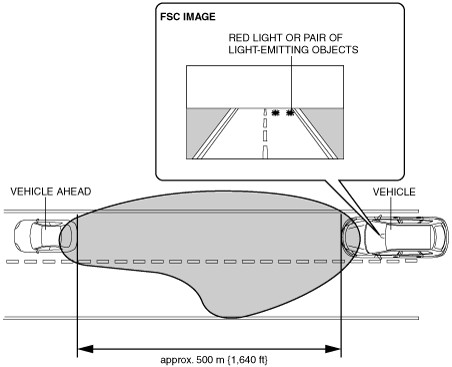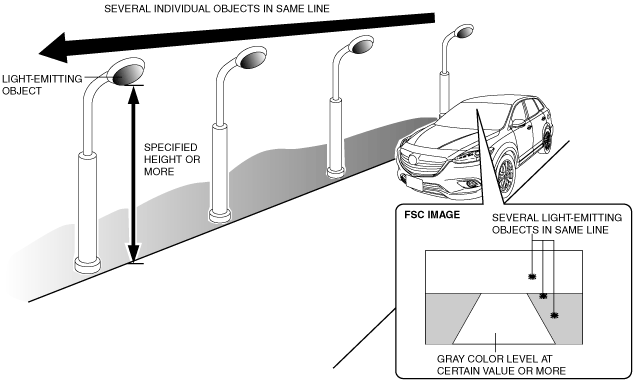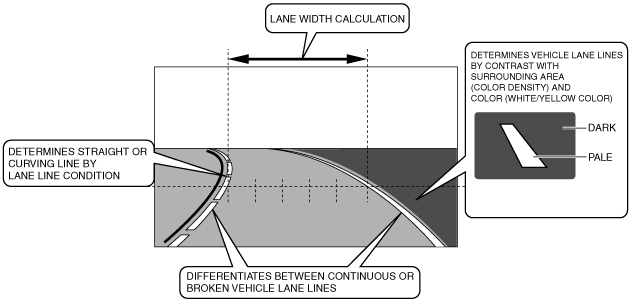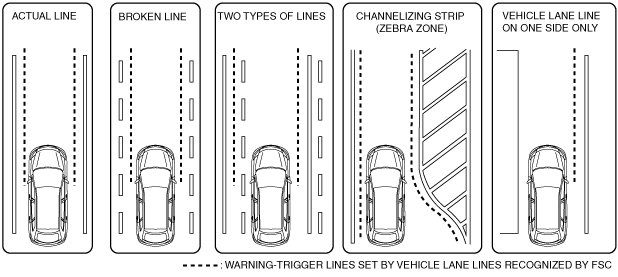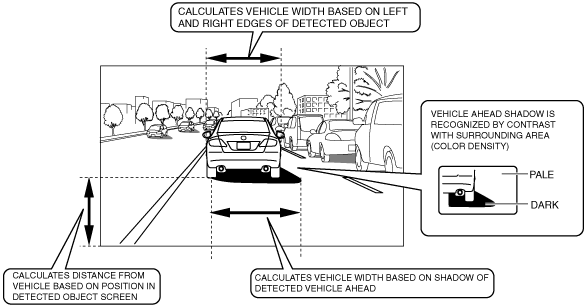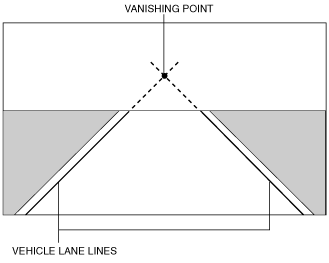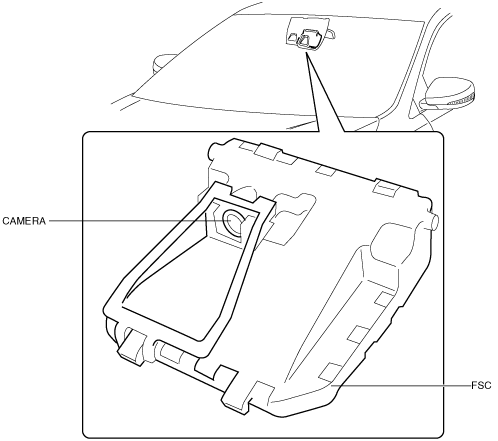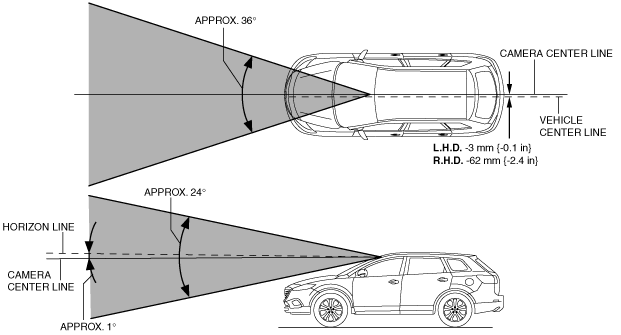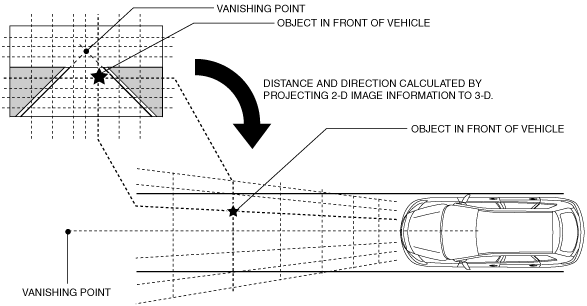FORWARD SENSING CAMERA (FSC)
id092200029300
Purpose
• The Forward Sensing Camera (FSC) recognizes light-emitting objects, vehicle lane lines, and the vehicle ahead based on the images picked up at the front of the vehicle, and controls the high beam control (HBC) system, lane departure warning system (LDWS), and Forward Obstruction Warning (FOW) system.
Function
Light-emitting object (vehicle ahead, vehicle ahead, street lights) recognition function
-
• The camera analyzes the light-emitting object it picks up and recognizes it as an vehicle ahead, vehicle ahead, or street lights (traveling on town/city streets).
-
Vehicle ahead recognition function (used mainly with HBC system)
-
• The FSC recognizes a light-emitting object that is within at least approx. 600 m from the detecting vehicle as an vehicle ahead when any of the following conditions are met:
-
― Light-emitting object approaches having brightness of specified value or more
― Light-emitting object approaches having white color and certain level of brightness or more (if it approaches and brightness changes, determination made at point of image capture)
-
Note
-
• If the vehicle ahead and the surrounding conditions are as follows, the FSC may require time until it recognizes an vehicle ahead.
-
― Poor visibility due to rain and fog
― Vehicle ahead is travelling with only TNS or fog lights
― Brightness of light source, such as vehicle, lowers
-
Vehicle ahead recognition function (used mainly with HBC system)
-
• The FSC recognizes a light-emitting object that is within at least approx. 500 m of the detecting vehicle as a vehicle ahead, and when any of the following conditions is met:
-
― Red light emitted from light-emitting object is detected
― Determines that there is a pair of light-emitting objects
-
Note
-
• To prevent dazzling from other vehicles a priority, the system could recognize reflecting objects on the road surface or a guard rail as a vehicle ahead (switches to low beams).
• If visibility is poor due to rain or fog, a vehicle ahead may not be recognized even though one may exist (maintains high beams).
-
Town/city streets recognition function (used mainly with HBC system)
-
• Travel on town/city streets is recognized in the following cases:
-
― Several light-emitting objects of certain height or more from road surface along same line are detected
― Camera image gray color is certain level or less
-
Note
-
• Even during travel other than at night or on town/city streets, if the road surface is bright from moonlight, the system may recognize that the vehicle is traveling on town/city streets (switches to low beams).
Vehicle lane lines and travel lane recognition function (used mainly with HBC system)
-
• The FSC recognizes line shapes which are paler than the surrounding color, and white/yellow lines as vehicle lane lines by the contrast (color density) of the camera image.
• If the vehicle lane lines are continuous they are recognized as actual lines, if discontinuous they are recognized as broken lines.
• The travel lanes recognized from the vehicle lane lines on the left and right of the vehicle are used to calculate the width.
• Traveling in a straight line or cornering is determined by the status of the vehicle lane lines.
Warning-trigger line setting function (used with LDWS)
-
• The FSC sets the warning-trigger lines *1 at approx. 5 cm inside of the recognized vehicle lane lines, and if the vehicle contacts a warning-trigger line, the warning is triggered.
• If there is only one vehicle lane line or only one vehicle lane line can be recognized, the warning-trigger line is set to only the recognized vehicle lane line.
• If the FSC recognizes both broken vehicle lane lines and actual vehicle lane lines, the warning-trigger line is set to the actual vehicle lane line.
*1 :The distance from the vehicle lane lines to the warning-trigger lines can be changed using the personalization. Refer to for details.
Vehicle ahead and vehicle distance recognition function (used with FOW system)
-
• The FSC recognizes the vehicle ahead and the shadow of the vehicle ahead from the shape of the object and contrast (color density) detected by the camera. The FSC calculates the vehicle width from the left and right edges and the shadow of the recognized vehicle ahead, and the distance between the detecting vehicle and the vehicle ahead based on the width and the position in the recognized vehicle ahead screen.
-
Note
-
• The vehicle width is calculated based on the taillights of the vehicle ahead in addition to the left and right edges and the shadow of the vehicle ahead while driving at night.
Aiming correction function
-
• The FSC adjusts the camera shot angle by aiming, and stores the vanishing point *1. The stored vanishing point and the current vanishing point are compared and if there is a deviation of a certain value or more in the vanishing point, the current vanishing point is stored as the new vanishing point.
*1 :The vehicle lane lines on the road surface are parallel and do not intersect, however, when viewed by the camera image, the lines converge in the distance and eventually cross. The point at which the lines cross is called the vanishing point.
HBC indicator light (green)/HBC warning light (amber) burnt out bulb check function
-
• When the ignition is switched ON, the FSC illuminates the HBC indicator light (amber) for approx. 3 s and performs a blown fuse check of the indicator light/warning indicator light.
On-board diagnostic function
-
• The FSC detects soiling and fogging of the camera lens and windshield glass, FSC transmission errors, FSC internal malfunctions, and outputs DTCs. For DTC details, refer to the On-board Diagnostic System [FSC]. (See
ON-BOARD DIAGNOSTIC [FORWARD SENSING CAMERA (FSC)].)
Construction
• Installed to the windshield.
• By integrating a small, color CMOS camera *1 with the control module, lightness and size reduction have been achieved.
• The FSC transmits between other modules using CAN.
*1 :Camera with high sensitivity CMOS (Complementary Metal-Oxide Semiconductor) picture element
Operation
Camera range
-
• The FSC camera shoots in the following range.
-
Note
-
• The FSC may be unable to pickup an object within the camera range in front of the vehicle, and not recognize it as a controlled target object depending on the surrounding conditions (ascending roads, winding roads, walls).
Position calculation
-
• When an object appears on the screen, the FSC determines the position coordinates, and from the coordinates it calculates the distance of the vehicle to the object and the direction.
Fail-safe
• Refer to HBC system fail-safe. There is no fail-safe in the LDWS and FOW systems.
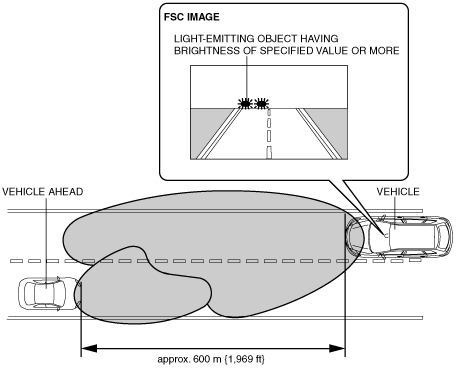 ac9wzn00000963
ac9wzn00000963